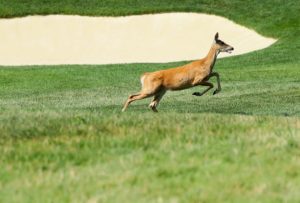
The association understands you have a soft heart and good intentions, but feeding deer is not in their best interests, or yours.
Depending on what you feed them, deer may actually be harmed by your feeding. Some foods will kill them within a few days or debilitate them enough to be easy targets for predators and automobiles.
Feeding is a way of domesticating deer. Tame deer create a host of other problems. Because they no longer fear people, they become vulnerable to hunters. They are emboldened to eat the shrubs in your vicinity. They will bring more deer into your yard and more deer ticks. And concentrations of deer attract coyotes and wolves—who will kill your pets along with the deer.
Deers adapt very easily to people, but they don’t need to be fed by them. They survive fine on their own. Better, in fact. Usually the weather controls deer populations, but deer fed by people increase regardless of the weather. This leads to overpopulation and disease.
Deer browsing in the back yard may be charming, but Lyme disease and roadkill are not. Please don’t feed the deer; let them be as nature intended.
Just to recap the four main reasons not to feed the deer.
HUMAN SAFETY AND PROPERTY DAMAGE
• Wild animals are dangerous. By feeding wild animals, you may be conditioning them to expect food from people. Deer that lose their natural tendency to avoid people can become a significant threat.
• Deer can attract predators such as coyotes and wolves. This would increase safety concerns and risk to people and pets.
• When deer are attracted to homes or farms, the risk for vehicle collisions increases. This can result in numerous deer fatalities, expensive vehicle repairs and human injury.
• Deer attracted to artificial or supplemental food sources will also feed on neighbors’ flowers, trees, shrubs or on farmers’ hay bales.
DEER HEALTH AND SAFETY
• A deer’s digestive system changes slowly with the seasons. In winter, their system adapts to allow them to digest relatively low-quality food like twigs, buds and stems.
• Rapid or dramatic changes to this winter diet can lead to bloating, diarrhea, enteritis and in some cases, death.
• Deer have starved to death with full stomachs in winter because they could not digest high carbohydrate foods like hay, grains, corn and alfalfa.
• Deer will travel long distances to reach an artificial food source. This may increase exposure to predators and other hazards (ex: increased risk of vehicle collision with more frequent highway crossings).
OVERABUNDANCE
• Natural processes limit deer populations to a level where they live in balance with their habitat. Winter mortality is normal. This natural mortality varies from year to year, but helps ensure the deer population stays at, or below, what the habitat can support.
• Research shows that providing extra food can raise deer reproduction and survival rates. Deer populations can increase to levels too high for the habitat to sustain causing long-term damage to that habitat. This damage can affect the deer population, vegetation and a wide variety of other wildlife species that depend on the habitat for food, nesting or shelter.
DISEASE TRANSMISSION
• Deer gathered at artificial food sources have a higher risk of transmitting diseases such as bovine tuberculosis, chronic wasting disease, brucellosis and parasites to one another.
I hope you found this information helpful, and should you have a subject you would like me to write about please contact me at Lgoguet@scotchhallpreservehoa.com
I hope you have a great weekend!
Laura Goguet
Community Manager